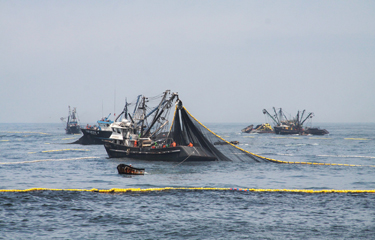Peru’s Production Ministry (PRODUCE) has traditionally opened the anchovy fishing season for the north-central zone in the days following Easter break, and the country’s fishing companies are eagerly awaiting the launch after only catching 80 percent of the total allowable catch (TAC) in the previous season.
The country’s anchovy fishery, which targets both Engraulis ringens and Anchoa nasus, is the largest by volume in the world and is a primary source of much of the world’s fishmeal and fish oil. Peru divides its anchovy fishing areas into two regions – south and north-central – with different capture limits and seasons set for each. The north-central is Peru’s main fishing region, with capture measuring several times that of the south region.
While fishers remain positive about the season with the knowledge that the anchovy biomass is healthy at some 10 million metric tons (MT), there are some obstacles that need to be faced, according to Adriana Giudice, the CEO of San Isidro, Peru-based fishing company Austral Group.
“There has been a mixture of juveniles and adults and that has made it difficult to catch to the extent that it led to many banned areas [during the last season], about 80 areas closed, and that makes fishing difficult,” she told SeafoodSource. “There will always be an incidence of juveniles, so there are limits established by [the Peruvian Institute for Marine Studies] Imarpe in the percentage of juveniles allowed in catches. We just hope that the biomasses separate a little more as was normal before, with a lower incidence.”
Other issues out of the fishing companies’ control could also affect the season, such as increased rain and wind, and fluctuating sea temperatures and salinity, which may send the biomass to deeper waters, she said.
“We have seen very cold years lately that have caused a lot of mixing between adults and juveniles, and there are smaller fish that are already spawning, which could be an effect of climate change,” Giudice said. “A long time ago this happened with hake in the north, in which authorities had to reduce the minimum capture-size because they realized that hake had reduced in size, but continued to spawn and have a life cycle.”
In the particular case of Austral Group, during the last season “we didn’t do well,” Guidice said, with the company catching 70 percent of its alloted quota.
“The truth is that it was one of the most-complicated seasons we have had in the last few years…This was due to the location of the fishing in the far north, where we have no plants and we could only work with the Coishco plant and to some extent with the Chancay plant,” Giudice said. “The fishing was mostly further north, up in Bayóvar, so it was very complicated.”
Observers also acknowledge that PRODUCE opened that season too late in the year, toward the end of November. With most fishing crews taking holiday breaks in December, it created a labor crunch for fishing firms.
The lower-than-expected catch will affect Austral Group’s ...
Photo courtesy of Sociedad Nacional de Pesquería








